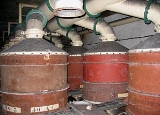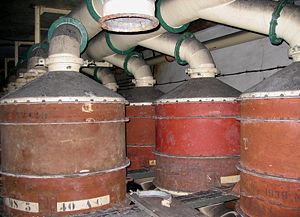
Ouvrage Billig
Encyclopedia
Ouvrage Billig, a gros ouvrage or large fortification of the Maginot Line
, was located in the Fortified Sector of Thionville
, Moselle in northern France
. It is located between the gros ouvrages Metrich
and Hackenberg
, facing Germany
. It saw relatively little action during World War II and after a period of reserve duty in the 1950s, was abandoned in the 1970s.
Billig was not subjected to significant attack by the Wehrmacht
in 1940, although an aerial bomb penetrated the 81mm mortar turret in Block 6 on 15 June, killing two. The area around Billig did not become active until late June of 1940, but German infiltration persisted until the June 25 armistice. Billig fired 2030 75mm shots in support of Hackenberg
on the 24th. After the armistice Billig was used for explosive effects testing by the Germans. Blocks 1 and 2 and the magazine of Block 5 were subjected to projectile penetration tests and gas explosions. Block 2's turret was blasted into the air, falling back into its opening.
Billig was assaulted by the U.S. 90th Infantry Division in September 1944 and captured after two days of fighting, using close-assault tactics. Following capture, Billig was used for ordnance testing by the U.S. Army. Following the war, the Maginot Line was viewed as a means of slowing an advance by Warsaw Pact
forces and most of the northeastern positions were renovated and rearmed. Replacement of 75mm guns with 105mm guns was proposed for Billig. However, the program was abandoned, and after a period of routine maintenance, Billig's status was lowered to inactive reserve, and finally abandoned.

Maginot Line
The Maginot Line , named after the French Minister of War André Maginot, was a line of concrete fortifications, tank obstacles, artillery casemates, machine gun posts, and other defences, which France constructed along its borders with Germany and Italy, in light of its experience in World War I,...
, was located in the Fortified Sector of Thionville
Fortified Sector of Thionville
The Fortified Sector of Thionville was the French military organization that in 1940 controlled the section of the Maginot Line immediately to the north of Thionville. The sector describes an arc of about , about halfway between the French border with Luxembourg and Thionville. The Thionville...
, Moselle in northern France
France
The French Republic , The French Republic , The French Republic , (commonly known as France , is a unitary semi-presidential republic in Western Europe with several overseas territories and islands located on other continents and in the Indian, Pacific, and Atlantic oceans. Metropolitan France...
. It is located between the gros ouvrages Metrich
Ouvrage Metrich
Ouvrage Métrich located in the village of Kœnigsmacker in Moselle, comprises part of the Elzange portion of the Fortified Sector of Thionville of the Maginot Line. A gros ouvrage, it is the third largest of the Line, after Hackenberg and Hochwald. It lies between petit ouvrage Sentzich and gros...
and Hackenberg
Ouvrage Hackenberg
Ouvrage Hackenberg, one of the largest of the Maginot Line fortifications, is part of the Fortified Sector of Boulay. It is situated twenty kilometers east of Thionville, in the Moselle département, near the village of Veckring, on the Hackenberg . It is located between gros ouvrage Billig and...
, facing Germany
Germany
Germany , officially the Federal Republic of Germany , is a federal parliamentary republic in Europe. The country consists of 16 states while the capital and largest city is Berlin. Germany covers an area of 357,021 km2 and has a largely temperate seasonal climate...
. It saw relatively little action during World War II and after a period of reserve duty in the 1950s, was abandoned in the 1970s.
Design and construction
Billig was approved for construction by CORF (Commission d'Organisation des Régions Fortifiées), the Maginot Line's design and construction agency, in June 1930 and became operational by 1935, at a cost of 65 million francs. The contractor was Ossude of Paris.Description
This gros ouvrage is unusual in having one entrance for both ammunition and personnel. It lacks the large "M1" magazine of other gros ouvrages. The dogleg-shaped layout is relatively short for a gros ouvrage, with less than 1000 metres (3,280.8 ft) of underground gallery at an average depth of 30 metres (98.4 ft) from the entrance to the farthest combat block. Like all gros ouvrages, Billig was provided with a 60cm railway running through the gallery system to provide materiel. The railway continued out the single entrance and connected to the railway system paralleling the front in the rear zones.- Mixed entry: Inclined ramp, two automatic rifle/anti-tank gun embrasures (JM/AC47). The mixed entry combines ammunition and personnel access, which is usually separated in a gros ouvrage.
- Block 1: Infantry block with one JM/AC47AC 47 anti-tank gunThe AC 47 was a French anti-tank gun of 47mm caliber. It was principally used in the ouvrages and casemates of the Maginot Line in the late 1930s; another version was created for naval use....
embrasure, one machine gun embrasure (JM) and two automatic rifle cloches (GFM)GFM clocheThe GFM cloche was one of the most common defensive armaments on the Maginot Line. A cloche was a fixed and non-retractable firing position made of a thick iron casting which shielded its occupant...
. - Block 2: Infantry block with one machine gun turret and one GFM cloche.
- Block 3: Infantry block with one JM/AC37 embrasure, one JM embrasure and two GFM cloches.
- Block 4: Artillery block with two 75mm gun embrasures, one 75mm gun turret, one grenade launcher cloche (LG)LG clocheThe LG cloche was a defensive element common to many Maginot Line ouvrages. The fixed cupola was deeply embedded into the concrete on top of a combat block, with only the top surface visible. The opening permitted the ejection of grenades from the interior of the cloche, providing a means of...
and one GFM cloche. - Block 5: Artillery block with two 75mm gun embrasures and one GFM cloche.
- Block 6: Artillery block with 81mm mortar turret and one GFM cloche.
- Block 7: Observatory block with one GFM cloche, one grenade launcher cloche and one periscope cloche (VDP)VDP clocheThe VDP cloche was an element of the Maginot Line fortifications. A cloche was a fixed and non-retractable firing position made of a thick iron casting which shielded its occupant. By comparison, turrets could be rotated and sometimes lowered so that only the top shell was exposed. VDP cloches...
.
Casemates and shelters
Several small blockhouses with machine guns and anti-tank guns were located around Billig. The Casernement d'Elzange provided peacetime above-ground barracks and support services to Billig and other ouvrages in the area.Manning
The manning of the ouvrage in 1940 comprised 521 men and 16 officers of the 167th Fortress Infantry Regiment and the 151st Position Artillery Regiment. The units were under the umbrella of the 42nd Fortress Corps of the 3rd Army, Army Group 2.History
- See Fortified Sector of ThionvilleFortified Sector of ThionvilleThe Fortified Sector of Thionville was the French military organization that in 1940 controlled the section of the Maginot Line immediately to the north of Thionville. The sector describes an arc of about , about halfway between the French border with Luxembourg and Thionville. The Thionville...
for a broader discussion of the events of 1940 in the Thionville sector of the Maginot Line.
Billig was not subjected to significant attack by the Wehrmacht
Wehrmacht
The Wehrmacht – from , to defend and , the might/power) were the unified armed forces of Nazi Germany from 1935 to 1945. It consisted of the Heer , the Kriegsmarine and the Luftwaffe .-Origin and use of the term:...
in 1940, although an aerial bomb penetrated the 81mm mortar turret in Block 6 on 15 June, killing two. The area around Billig did not become active until late June of 1940, but German infiltration persisted until the June 25 armistice. Billig fired 2030 75mm shots in support of Hackenberg
Ouvrage Hackenberg
Ouvrage Hackenberg, one of the largest of the Maginot Line fortifications, is part of the Fortified Sector of Boulay. It is situated twenty kilometers east of Thionville, in the Moselle département, near the village of Veckring, on the Hackenberg . It is located between gros ouvrage Billig and...
on the 24th. After the armistice Billig was used for explosive effects testing by the Germans. Blocks 1 and 2 and the magazine of Block 5 were subjected to projectile penetration tests and gas explosions. Block 2's turret was blasted into the air, falling back into its opening.
Billig was assaulted by the U.S. 90th Infantry Division in September 1944 and captured after two days of fighting, using close-assault tactics. Following capture, Billig was used for ordnance testing by the U.S. Army. Following the war, the Maginot Line was viewed as a means of slowing an advance by Warsaw Pact
Warsaw Pact
The Warsaw Treaty Organization of Friendship, Cooperation, and Mutual Assistance , or more commonly referred to as the Warsaw Pact, was a mutual defense treaty subscribed to by eight communist states in Eastern Europe...
forces and most of the northeastern positions were renovated and rearmed. Replacement of 75mm guns with 105mm guns was proposed for Billig. However, the program was abandoned, and after a period of routine maintenance, Billig's status was lowered to inactive reserve, and finally abandoned.

See also
- List of all works on Maginot Line
- Siegfried LineSiegfried LineThe original Siegfried line was a line of defensive forts and tank defences built by Germany as a section of the Hindenburg Line 1916–1917 in northern France during World War I...
- Atlantic WallAtlantic WallThe Atlantic Wall was an extensive system of coastal fortifications built by Nazi Germany between 1942 and 1944 along the western coast of Europe as a defense against an anticipated Allied invasion of the mainland continent from Great Britain.-History:On March 23, 1942 Führer Directive Number 40...
- Czechoslovak border fortificationsCzechoslovak border fortificationsThe Czechoslovak government built a system of border fortifications from 1935 to 1938 as a defensive countermeasure against the rising threat of Nazi Germany that later materialized in the German offensive plan called Fall Grün...
External links
- La Ligne Maginot - Billig
- Billig at fortiff.be
- Billig at darkplaces.org

